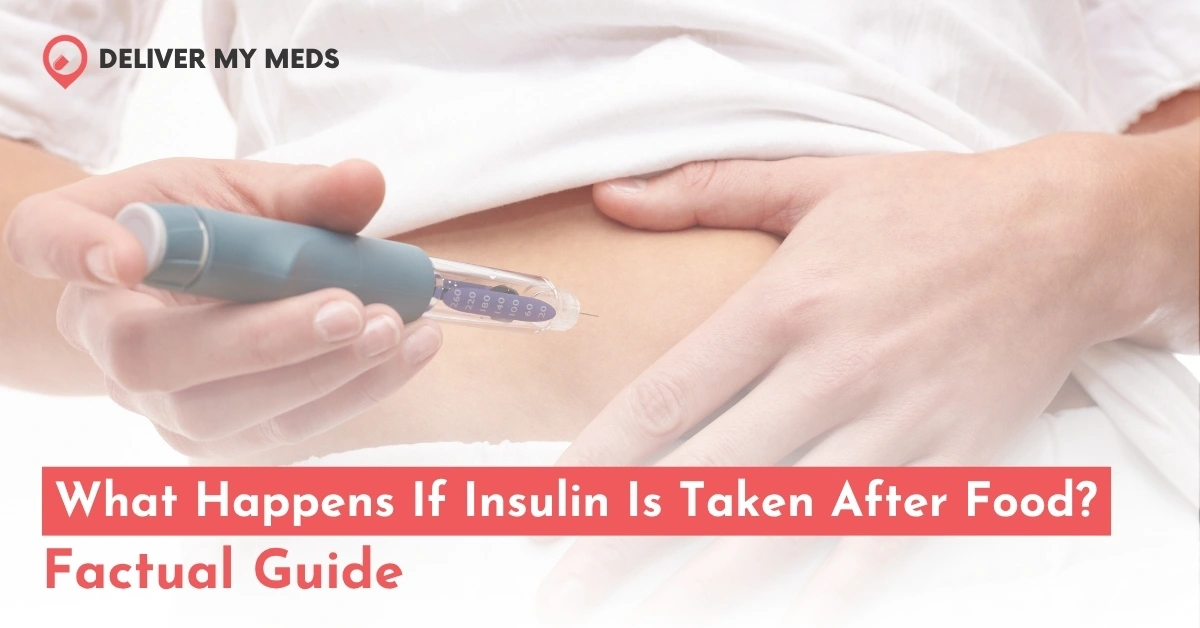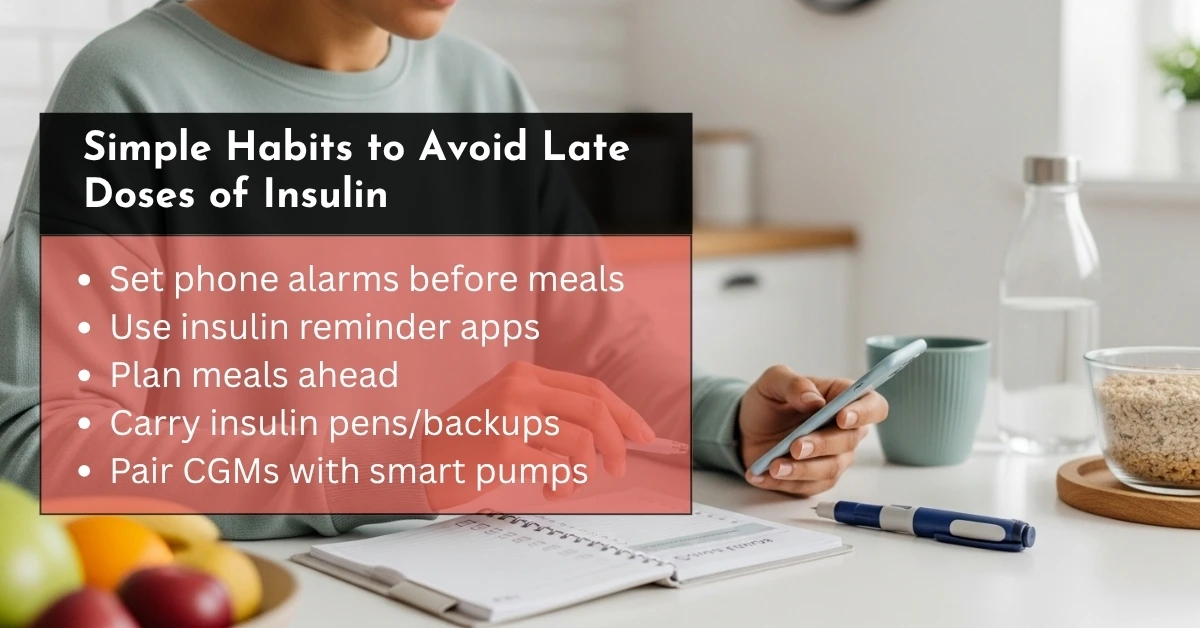
What happens if insulin is taken after food is something many people ask, especially those who use insulin daily. Timing really matters. After eating, your blood sugar may rise quickly if you take insulin too late. Later, it can drop suddenly, leading to tiredness or low sugar symptoms.
In this blog, we’ll guide you through what happens inside your body when insulin is delayed, why pre-meal timing matters, and how different types of insulin behave after food. You’ll also learn whether it’s safe to take insulin one or two hours after eating, what signs to look for if your dose is late, and how to safely correct it. This guide is here to help you manage real-life situations.
Effects of Taking Insulin After a Meal
You completely disturb your body when you take insulin late, after eating. Typically, insulin is taken before eating to help your body manage the sugar from food as it enters the bloodstream.
But when insulin is delayed:
- Blood sugar rises more than usual (post-meal spike)
- Glucose stays high for longer
- A delayed drop in sugar (hypoglycemia) can happen hours later
Fast-acting insulin works best when taken ahead of food. Delaying it causes mismatched peaks, making sugar levels harder to control.
Timing Must Match the Type of Insulin
The time gap between insulin and food depends on which insulin you use. Here’s a simple guide:
| Insulin Type | Best time before meal |
| Rapid-acting (e.g., Lispro, Aspart) | 10-15 minutes before meals |
| Short-acting (Regular) | 30 minutes before meals |
| Premixed | Follow the doctor’s instructions |
| Long-/Intermediate-acting | Same time daily, not meal-based |
Rapid-acting insulin should be taken early to match digestion. Long-acting insulin provides background control and isn’t tied to meals.
Taking Insulin Two Hours After Eating
Taking insulin two hours after a meal isn’t usually recommended, but sometimes, it might be necessary, especially if your blood sugar stays high after eating. Many people wonder, “Is it okay to take insulin this late?” The answer depends on the situation. If your glucose is still elevated and your doctor has advised it, a delayed correction dose may be helpful. But this should never become routine.
Here’s what to keep in mind:
- Talk to your doctor or care team before adjusting your timing
- Check your sugar again 2-3 hours after the injection to avoid going too low later
- Try not to make this a habit it can throw off your overall glucose control
Delaying insulin too long makes it harder to manage your numbers and increases the risk of both highs and lows later in the day.
When Delayed Insulin Dosing Makes Clinical Sense
In some situations, delaying insulin until after a meal may be the safer choice. Here’s when it’s okay to delay insulin dosage:
- If a child or elderly person doesn’t take insulin before their meal, it’s better to wait and see what portion was eaten. Always give insulin doses afterwards with monitoring. Giving a full insulin dose beforehand can result in hypoglycemia.
- Diabetics using continuous glucose monitors (CGMs) like FreeStyle Libre 3 plus or Dexcom G7 have to adjust insulin after meals. They can delay it through real-time glucose trends monitoring as they don’t rely on fixed pre-meal doses.
- In patients with gastroparesis (a condition where food digests slowly), the blood sugar rise is delayed. Giving insulin too early can be dangerous. A delayed post-meal dose, guided by readings from Guardian Connect or Guardian Sensor 3, is recommended.
Important: Some insulin pumps, like the Omnipod 5 or MiniMed 770G, can automatically adjust both basal and bolus insulin based on your real-time glucose after meals. This means you don’t have to guess how much insulin to take; they respond to your body’s needs
How to Know If You Took Insulin Too Late
Late insulin dosing changes your body’s typical glucose pattern:
- Blood sugar remains elevated 1-2 hours post-meal
- 4-5 hours later, a steep drop can occur
- You may feel shaky, thirsty, moody, or fatigued
- CGM data may show insulin activity peaking after the glucose spike
A mismatch between food and insulin leads to poor control and unpredictable symptoms.
What to Do If You Missed an Insulin Dose
If you have forgotten to take insulin before a meal:
- Monitor your blood glucose 1-2 hours after a meal
- Use data from your Dexcom G7 Receiver or FreeStyle Libre 3 Reader to fine-tune your dose.
- If the blood glucose is high, give a correction dose based on your sliding scale
- Watch closely after that to prevent insulin stacking (too much insulin in your system)
- For those not on sensors, home blood pressure monitors like the Omron 5 Series or 7 Series Wireless can also track hypertension comorbidities during insulin therapy.
Note: Never double your next dose. Always adjust according to your current readings, not past mistakes. If you want to learn more about missed dosage signs with proper guidance, check this DMM’s expert guide about missed insulin symptoms with precautions.
Insulin Should Never Be Taken Orally
A common myth is that insulin can be taken like a pill. So, can you drink insulin instead of injecting it? Not.
Here’s why:
- Insulin is a protein and breaks down in your digestive system like food.
- It never enters the bloodstream when taken by mouth.
- Only injected or pump-delivered insulin is effective.
If you’re struggling with injections, ask your doctor about pen devices or pumps that make it easier or just click on the shop of DMM for many varieties.
How CGMs Help with Insulin Timing
Modern tools like Continuous Glucose Monitors (CGMs) such as Dexcom G7 and Freestyle Libre 3 can:
- Show real-time glucose levels
- Help you decide if a correction dose is needed
- Send alerts if you miss a dose or if your sugar is too high/low
- Track patterns for better long-term control
- CGMs allow smarter decisions instead of guessing when or how much insulin to take.
Simple Habits to Avoid Late Doses of Insulin
To prevent missed or late insulin doses:
- Set phone alarms before meals
- Use reminder apps linked to your insulin schedule
- Plan your meals when possible
- Always carry insulin pens or backups when leaving home
- Pair CGMs with smart insulin pumps like the Omni-pod 5 for automation
At Deliver My Meds, we help you get covered CGMs, pumps, and fast-shipping insulin devices to support your routine.
Talk to Your Doctor If You Often Take Insulin Late
Seek help from your care team if you:
- You often forget insulin doses
- Your CGM shows frequent spikes or drops
- You feel unsure about adjusting doses after meals
- You experience signs of insulin resistance
Medical advice helps you make safe, informed decisions, especially if your routine is changing.
Conclusion
What happens if insulin is taken after food depends on the type of insulin, how late it’s taken, and your blood sugar levels. Sometimes you might need to take it after meals, but it shouldn’t be your norm. You need to take insulin prior to meals to control the increase in blood sugar after meals. If you take it late, you will need to adjust according to your type of insulin, meal size, and current blood sugar. With devices such as Continuous Glucose Monitors (CGMs), you will be able to adjust safely. But if you’re taking insulin late very often, it leads to unstable highs and lows of your blood sugar. That’s why timing is crucial.




